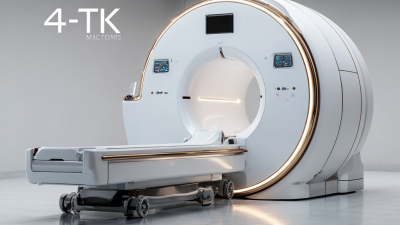The integration of Mobile Imaging into telemedicine has sparked a revolutionary transformation in healthcare delivery. According to a report by IQVIA, the global telemedicine market is projected to reach $459.8 billion by 2030, significantly driven by advancements in portable imaging technologies.
 Mobile Imaging facilitates immediate access to high-quality diagnostic imaging, enabling healthcare providers to make timely decisions and improving patient outcomes. This rapid deployment of imaging capabilities, especially in rural and underserved areas, has been shown to increase the efficiency of healthcare systems, as evidenced by a study published in the
Journal of Telemedicine and Telecare, which found that telemedicine consultations leveraging mobile imaging can reduce patient wait times by up to 50%. As healthcare continues to evolve, the strategic incorporation of Mobile Imaging will play a pivotal role in enhancing telemedicine solutions, ultimately leading to a more responsive and accessible healthcare landscape.
Mobile Imaging facilitates immediate access to high-quality diagnostic imaging, enabling healthcare providers to make timely decisions and improving patient outcomes. This rapid deployment of imaging capabilities, especially in rural and underserved areas, has been shown to increase the efficiency of healthcare systems, as evidenced by a study published in the
Journal of Telemedicine and Telecare, which found that telemedicine consultations leveraging mobile imaging can reduce patient wait times by up to 50%. As healthcare continues to evolve, the strategic incorporation of Mobile Imaging will play a pivotal role in enhancing telemedicine solutions, ultimately leading to a more responsive and accessible healthcare landscape.
Mobile imaging technologies are significantly enhancing the accuracy of remote patient diagnosis in telemedicine. By bringing advanced diagnostic tools directly to patients, mobile imaging facilitates timely and efficient evaluations, especially in underserved areas. These innovations allow healthcare providers to conduct essential imaging tests such as X-rays and ultrasounds at the patient's location, bridging the gap between remote consultations and necessary medical assessments.
In regions like Kenya, artificial intelligence is playing a crucial role in augmenting mobile imaging capabilities, providing clinicians with powerful tools to interpret complex images accurately. This integration not only streamlines workflows but also helps in addressing diagnostic disparities, thereby improving healthcare delivery in remote settings. As the market for mobile imaging services is projected to grow substantially in the coming years, its impact on telemedicine solutions becomes increasingly prominent, making healthcare more accessible and precise for a broader population.
The growth of mobile imaging technologies is significantly reshaping the landscape of telemedicine. From 2024 to 2031, the digital health market is expected to surge from $2.4014 billion to $13.9481 billion, marking a compound annual growth rate (CAGR) of 28.57%. This stark rise underscores the increasing reliance on mobile imaging solutions, which facilitate remote diagnostics and enhance patient care accessibility. Advanced imaging devices are being integrated into telehealth practices, allowing for immediate assessments and timely interventions.
Key technologies driving this transformation include AI-powered retinal screening devices, estimated to grow from $2.2 billion in 2025 to $6.1 billion by 2034, with a CAGR of 12.3%. Additionally, advancements in healthcare IT are enabling seamless integration of clinical solutions and mobile health applications, further propelling the adoption of remote healthcare services. By harnessing these innovative technologies, healthcare providers can improve diagnostic efficiency and offer personalized patient care, ultimately leading to improved health outcomes in an increasingly digital world.

The telemedicine market has witnessed significant growth, with its value estimated at USD 104.64 billion in 2024 and projected to reach USD 111.99 billion in 2025. This rapid expansion is complemented by the rise of mobile medical imaging, which is revolutionizing healthcare delivery by providing advanced diagnostic capabilities that can be accessed directly by patients. Such integration enhances patient engagement and streamlines the diagnostic process, allowing for timely and efficient treatments.
The use of deep learning in medical imaging is another pivotal development. Recent studies indicate that deep learning models are achieving high accuracy in analyzing medical images, particularly in the context of diseases like Alzheimer’s Disease. These technological advancements not only improve diagnostic precision but also expand the scope of telemedicine, empowering healthcare providers to offer better remote care.
**Tips:** When exploring telemedicine options, consider platforms that incorporate mobile imaging capabilities to enhance the quality of care. Additionally, staying informed about advancements in deep learning can help patients and providers alike leverage the full potential of these innovations for more accurate diagnoses and treatment plans.
This chart illustrates the growth of telemedicine and mobile imaging usage from 2019 to 2023, highlighting the increasing reliance on digital healthcare solutions.
The integration of mobile imaging technologies into telemedicine has the potential to transform healthcare practices, enabling quicker diagnoses and more personalized patient care. However, several challenges must be navigated to effectively incorporate these tools into telehealth systems. Firstly, ensuring data security and patient privacy is paramount, as mobile imaging devices often transmit sensitive information over the internet. Healthcare providers must adopt robust cybersecurity protocols and comply with regulations such as HIPAA to protect patient data.
Additionally, training healthcare professionals to effectively use mobile imaging tools is crucial. A well-trained workforce can optimize the technology's benefits and improve patient outcomes. Providers should invest in ongoing education and hands-on training programs to ensure that their teams are adept at utilizing these advanced imaging solutions.
**Tips:** Evaluate the mobile imaging technology’s compatibility with existing telehealth systems before implementing it. Encourage open communication among healthcare teams to share insights and best practices regarding the use of mobile imaging, fostering a collaborative environment that enhances patient care. Lastly, consider patient feedback on mobile imaging experiences to continually refine telehealth practices and address any concerns they may have.
| Dimension | Challenge | Opportunity | Impact on Telehealth |
|---|---|---|---|
| Regulatory Compliance | Varying regulations across states | Standardization of procedures across regions | Streamlined processes for providers |
| Technology Integration | Compatibility issues with existing systems | Innovations in interoperability | Enhanced workflows for medical personnel |
| Data Security | Risk of data breaches | Advancements in cybersecurity measures | Increased patient trust |
| User Adoption | Resistance from healthcare providers | Education and training programs | Wider usage of telehealth services |
| Cost | High initial setup costs | Long-term savings through efficiency | Greater access to care at lower costs |
The evolution of mobile imaging in global healthcare delivery is poised to transform patient care and accessibility. As telemedicine continues to gain traction, mobile imaging technologies enable healthcare providers to conduct diagnostic imaging on-the-go. This flexibility not only expedites the diagnostic process but also allows for remote consultations, bridging the gap between patients and specialists across vast distances. With the integration of advanced imaging devices such as portable ultrasound machines and handheld X-ray systems, healthcare professionals can diagnose and treat conditions in real time, particularly in underserved and rural communities.

Looking ahead, the future of mobile imaging is intertwined with significant advancements in artificial intelligence and machine learning. These technologies will facilitate smarter imaging processes, enhancing the accuracy of diagnoses through automated analysis of images. As mobile imaging devices become more sophisticated and connected, the potential for remote monitoring and preventive healthcare increases, allowing clinicians to track patient health trends and intervene proactively. This evolution not only democratizes access to essential health services but also paves the way for more personalized and effective care delivery on a global scale.





